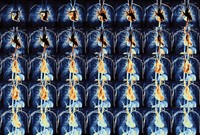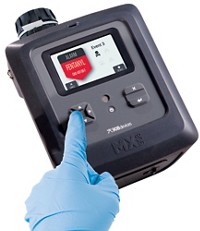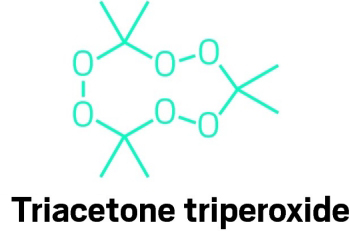Advertisement
Grab your lab coat. Let's get started
Welcome!
Welcome!
Create an account below to get 6 C&EN articles per month, receive newsletters and more - all free.
It seems this is your first time logging in online. Please enter the following information to continue.
As an ACS member you automatically get access to this site. All we need is few more details to create your reading experience.
Not you? Sign in with a different account.
Not you? Sign in with a different account.
ERROR 1
ERROR 1
ERROR 2
ERROR 2
ERROR 2
ERROR 2
ERROR 2
Password and Confirm password must match.
If you have an ACS member number, please enter it here so we can link this account to your membership. (optional)
ERROR 2
ACS values your privacy. By submitting your information, you are gaining access to C&EN and subscribing to our weekly newsletter. We use the information you provide to make your reading experience better, and we will never sell your data to third party members.
Analytical Chemistry
How Chemistry Is Helping Defeat Fuel Fraud
Novel detection systems for laundered diesel and gasoline succeed where dyes alone are failing
by Alex Scott
February 1, 2016
| A version of this story appeared in
Volume 94, Issue 5
In October 2015, Roland Gurney, 33, and his brother Stephen Gurney, 28, were convicted of laundering fuel in Northern Ireland.

They had used a bleaching agent to strip red marker dye from 4,500 L of subsidized diesel designated for agricultural, construction, and heating use. The brothers were found to be selling the laundered fuel on the open market. They were also found in possession of 1,200 L of toxic waste resulting from their fuel-laundering activities.
U.K. authorities say many more fuel fraudsters like the Gurneys are slipping through their hands. This is because once the dyes have been removed, laundered fuel cannot easily be identified. Fraudsters around the world typically remove dyes, such as the azo dye Solvent Red 26, by passing the fuel through an absorbent, such as activated carbon, or by washing the fuel with an acid or caustic soda.
To help governments curb fuel fraud, a handful of companies are introducing technologies that make it possible to identify laundered fuels. Innovations include a hydrocarbon molecule developed by Dow Chemical and a novel detection technology invented by a former U.K. chemistry professor.
Fuel fraud costs governments around the world about $100 billion annually, according to Addison, Texas-based Authentix, a provider of fuel-marking programs. The problem is particularly acute in Northern Ireland, where 8% of all fuels and 12–13% of diesel is illicit. The country loses about $1 billion in tax revenue annually as thieves resell laundered fuel for more than twice the subsidized or tax-free price of fuel still containing dye.
According to Authentix, the best solution to the problem of fuel fraud is a system that combines an invisible low-concentration marker with sensitive detection technology.
That’s the approach Dow has taken with its Accutrace fuel marker, or ((3-(sec-butyl)-4-(decyloxy)phenyl)methanetriyl)tribenzene. Approved in the U.K. last year, it “is robust enough and tough enough to resist the fraudsters,” says Warren E. Smith, a technical sales representative at the firm.
Dow’s scientists in the U.S. came up with the new molecule as a targeted solution to the fuel fraud problem. Dosing fuel with 2.5 mg/L of Accutrace, which cannot be seen by the naked eye, is all that is required to ensure that diesel, gasoline, or other fuels can be traced, Smith says.
Dow claims that its Accutrace marker will change the fuel fraud landscape because it’s difficult to remove from fuel. “For the fraudster, the problem moves from a simplistic chemistry to one that would need high-end technological capability,” Smith says.
Although Accutrace can’t readily be removed from fuel, it can be detected at the roadside in less than five minutes by enforcement officers using portable gas chromatography with flame ionization detection (GC-FID) equipment. Northern Ireland now has 49 vehicles fitted with GC-FID instruments and operated by trained officers.
In addition to being robust in the face of fraudsters, marker molecules must also not damage vehicles or the environment. Largely made up of carbon and hydrogen atoms, Accutrace has no effects on vehicles, Smith says, and is combusted into compounds already typically found in fuel exhaust.
The Dow marker is now required to be added, along with dye, to subsidized fuel sold in Northern Ireland. The U.K. government’s goal is for the technology to enable it to recoup at least half of the tax revenue it loses every year to fuel fraud. “Hopefully we will see a virtual eradication,” Smith says.
Since Accutrace was introduced in the U.K. in April 2015, a total of 1,299 detections have been made from 26,261 tests, of which 85 could not have been picked up without Accutrace, says the U.K. revenue and customs service.
Use of Accutrace is also benefiting authorities over the border in the Republic of Ireland. For example, in December 2015 in Ireland’s County Cavan, fraudsters were caught with fuel that they had bleached to remove dyes but that still contained Accutrace. The County Cavan fuel-laundering operations had been costing the government $5 million annually, according to Ireland’s Office of the Revenue Commissioners.
Authentix says fuel fraud is also a problem in Eastern Europe and in developing Asian countries. The firm estimates that a comprehensive antifraud program featuring a chemical marker should generate a return for governments of between 2.8 and 12.6 times their initial outlay.
Whereas Dow’s solution is a marker molecule, a technology developed by Peter White, a former U.K. forensic chemistry professor, and Singapore-based fuel marker company DeCipher uses a way of detecting trace concentrations of dyes in fuels that have been laundered.
The technology features a custom-built surface-enhanced resonance Raman scattering (SERRS) spectrometer in association with a patented silver colloid that enhances detection sensitivity. When the colloids are added to a fuel sample, dye molecules are drawn to them as a result of a charge attraction. Analyzed with the portable SERRS spectrometer, dyes can be identified at concentrations of around 1 ppb, an amount present even after fraudsters’ filtering or bleaching efforts.
Of the more than 200 potential dyes tested, a significant number have been identified as suitable for use with the SERRS-colloid system, White tells C&EN.
A key challenge for White was coming up with a colloid that was stable and reproducible and had a long shelf life. Silver colloids are often made by reducing silver nitrate with sodium citrate, but such colloids don’t last long.
White’s eureka moment came some years ago while working at the University of Lincoln when he switched sodium citrate for a phosphate salt. This generated a stable colloid with excellent reproducibility between batches and a shelf life of more than 12 months.
Today, Lincoln owns the patent for the colloid. The university licensed it to DeCipher for use relating to fuel fraud. White and DeCipher codeveloped the SERRS spectrometer, and DeCipher is now selling the system in a number of countries around the world.
Using the SERRS instrument and the colloid, fuel markers can be detected in less than five minutes, White says. “Another advantage of Raman spectroscopy is that a marker can produce unique spectra, and this allows mixtures of markers to be detected and identified,” he says.
White claims that the SERRS instrument is more robust and potentially much cheaper than GC-MS for detecting fraudulent fuel. He is also convinced that the SERRS system could be applied in other fields such as health care, in which it could identify counterfeit tablets and medicines.
With innovations such as SERRS technology and the Accutrace system in play, fuel launderers like the Gurney brothers—as well as fraudsters in other industries—could soon find it all but impossible to continue with their duplicitous ways.
CORRECTION:
This story was modified on Feb. 10, 2016, to clarify that U.K. officials use gas chromatography with flame ionization detection, not GC-mass spectrometry, for roadside detection of fuel fraud.






Join the conversation
Contact the reporter
Submit a Letter to the Editor for publication
Engage with us on Twitter